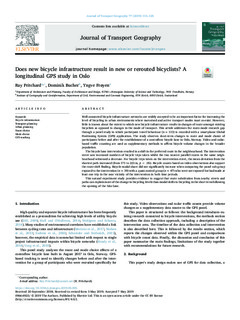| dc.contributor.author | Pritchard, Ray | |
| dc.contributor.author | Bucher, Dominik | |
| dc.contributor.author | Frøyen, Yngve Karl | |
| dc.date.accessioned | 2019-05-16T06:21:50Z | |
| dc.date.available | 2019-05-16T06:21:50Z | |
| dc.date.created | 2019-05-15T08:20:39Z | |
| dc.date.issued | 2019 | |
| dc.identifier.citation | Journal of Transport Geography. 2019, 77 113-125. | nb_NO |
| dc.identifier.issn | 0966-6923 | |
| dc.identifier.uri | http://hdl.handle.net/11250/2597744 | |
| dc.description.abstract | Well-connected bicycle infrastructure networks are widely accepted to be an important factor for increasing the level of bicycling in urban environments where motorised and active transport modes must co-exist. However, little is known about the extent to which new bicycle infrastructure results in changes of route amongst existing bicyclists as opposed to changes in the mode of transport. This article addresses the route-mode research gap through a panel study in which participant travel behaviour (n = 113) is recorded with a smartphone Global Positioning System (GPS) application. The study observes short-term changes to route and mode choice of participants before and after the establishment of a contraflow bicycle lane in Oslo, Norway. Video and radar-based traffic counting are used as supplementary methods to affirm bicycle volume changes in the broader population. The bicycle lane intervention resulted in a shift in the preferred route in the neighbourhood. The intervention street saw increased numbers of bicycle trips taken whilst the two nearest parallel routes in the same neighbourhood witnessed a decrease. For bicycle trips taken on the intervention street, the mean deviation from the shortest path increased (from 171 to 221 m, p < .05). Bicycle counts based on video observations also support the route shift finding. Bicycle modal share did not significantly increase when comparing the panel sub-group exposed to the intervention (n = 39) with a quasi-control group (n = 47) who were not exposed but had made at least one trip in the near vicinity of the intervention in both time periods. This natural experiment study provides evidence to suggest that route substitution from nearby streets and paths can explain more of the change in bicycling levels than modal shifts to bicycling in the short term following the opening of the bike lane. | nb_NO |
| dc.description.abstract | Does new bicycle infrastructure result in new or rerouted bicyclists? A longitudinal GPS study in Oslo | nb_NO |
| dc.language.iso | eng | nb_NO |
| dc.publisher | Elsevier | nb_NO |
| dc.relation.uri | https://www.sciencedirect.com/science/article/pii/S0966692318306689?via%3Dihub | |
| dc.rights | Attribution-NonCommercial-NoDerivatives 4.0 Internasjonal | * |
| dc.rights.uri | http://creativecommons.org/licenses/by-nc-nd/4.0/deed.no | * |
| dc.title | Does new bicycle infrastructure result in new or rerouted bicyclists? A longitudinal GPS study in Oslo | nb_NO |
| dc.type | Journal article | nb_NO |
| dc.type | Peer reviewed | nb_NO |
| dc.description.version | publishedVersion | nb_NO |
| dc.source.pagenumber | 113-125 | nb_NO |
| dc.source.volume | 77 | nb_NO |
| dc.source.journal | Journal of Transport Geography | nb_NO |
| dc.identifier.doi | 10.1016/j.jtrangeo.2019.05.005 | |
| dc.identifier.cristin | 1697937 | |
| dc.description.localcode | © 2019 The Author(s). Published by Elsevier Ltd. This is an open access article under the CC BY-NC-ND license (http://creativecommons.org/licenses/by-nc-nd/4.0/). | nb_NO |
| cristin.unitcode | 194,61,50,0 | |
| cristin.unitname | Institutt for arkitektur og planlegging | |
| cristin.ispublished | true | |
| cristin.fulltext | original | |
| cristin.qualitycode | 1 | |

